The Ivory Burn is about to happen and for days the internet has been full of pictures of the pyres being built, conservationists having their pictures taken with tusks, and heart-felt video pleas.
Despite the piles of tusks rising above the plains in some grotesque parody of a rural village, I’ve found it hard to contemplate the significance of what they mean in terms of individual lives. There are so many that it is overwhelming.
We’ve tried. We worked out that the number of tusks in the pyres represents a procession of elephants over 30 miles long, and while it creates a powerful mental image, it gets us no closer to the individuals.
I was looking through images of the piles of tusks, posted by Salisha Chandra, cofounder of KUAPO (Kenyans United Against Poaching), when one close-up caught my eye. What first drew my attention, was a spiral bound notebook, placed incongruously amongst the tusks. It was the tusk beside it though, that made me suddenly still.
Like all the tusks there it carried information as to where and when it had been recovered – all I could see was .. .KG VOI RIVER 30/5/14, but it was enough. It was written in the perfect hand-written capitals that Kenya’s 8:4:4 education system produces.
The tusk is one in ten thousand, seemingly unremarkable – but the date and location made me remember.
At first I thought it fanciful. It seemed inconceivable that the tusk has come from an elephant we’ve known and written about. Perhaps I’d been looking for a connection to an individual to make sense of the masses, and willed it to happen. I closed my eyes, thinking that when I opened them, I’d see a different date, a different location – but nothing changed.
What were the chances that I’d see a random photograph posted on the internet that would contain a tusk that was known to me? What were the chances of that particular tusk ending up on the outside of a pyre, with it’s date and location visible?
To check my memory, I went back to photographs we’d taken of a bull elephant that had been shot by poachers, next to our camp in May 2014. The tusk’s date and location matched the camera’s metadata – there was no mistake. I shivered, my surroundings dropped away, and I was transported back to that dry river bed, where a dead bull lay, his tusks gone, his bones scattered by hyaenas – and hanging over it all, the clinging stench of death.
The bull had been one of an all-male herd that had taken over a nearby seep – I’d called them ‘The Waterboys’. Downstream from camp was a tiny seasonal oxbow lake beside the Voi river. When the river dried-up, the bulls dug down to the water-table there and patiently waited for a trunkful of water. It seeped through so slowly that they’d spend most of the day there – each waiting their turn in a hierarchy based on size, age and tusk length. On hot days, by the time the smaller bulls were allowed in, the bigger bulls would be thirsty again. They knew they’d only have a minute or two and in their desperation to drink, would collapse the sides and the whole operation would start over again. Like the teenagers they were, the young bulls took their frustration out by squabbling and jousting – which just served to make them hotter and thirstier.
As the dry season set in and the level dropped, the water was more difficult to reach and then the tables turned. The older bulls with the longest tusks were at a disadvantage then, as their tusks prevented them lowering their faces close enough to drink.
At the end of May, there was still plenty of water in the seep. Our bull would have drunk and then wandered upstream to feed – light crunched feet in the sand – it was only a few hundred metres to where Ndololo’s giant figs provided shade and food. The bend in the river-bed there was favoured by families that couldn’t get to drink at the seep. The matriarchs would dig down – penduluming a foreleg to uncover water hidden beneath the sand. Our bull probably joined them for a while – enjoying their company. The irony was that, in the heart of the park amongst other elephants and within earshot of people at the camp, he probably felt safe. How wrong he was.
What I remembered most from that time, was the overpowering feeling that his death was as bad as it gets – a brazen attack with an automatic weapon, next to a camp, just a few kilometres from park headquarters.
I’d written about his death in 2014 in ‘Another place, another Bull’ http://tinyurl.com/zs5frbl
The attack had happened just after dark, half a mile from our camp.
“That evening, just after sunset, there was a burst of gun fire a short distance upstream and a bull elephant collapsed and bled out in the riverbed. We didn’t hear about it until dawn the next day. The shots were heard from a tented camp, and by people camping close-by. They contacted Kenya Wildlife Service – their headquarters are only ten minutes away. They responded rapidly, but by the time rangers arrived, the poachers had hacked out one tusk and fled. The rangers removed the other. Later that night, hyenas chewed the ears, and the bull became immediately unrecognisable – faceless – just another statistic in a developing genocide.
I could imagine the scene – a mature bull elephant, digging for water in the moonlight – surrounded by females and calves. Within seconds, the tranquility shattered; within hours, the bull reduced to a one-line entry in a KWS manifest, a bloodied and numbered tusk in a strongroom, and another – probably already strapped on a motor-bike, en route to Mombasa.”
The poachers had escaped with one tusk, and shortly afterwards police in Mombasa seized two tons of Tsavo ivory from a warehouse owned by businessman, Feisal Mohammed. He’d immediately fled the country, but was later arrested in Tanzania and brought back to Mombasa, where he is still awaiting trial.
The other tusk was removed by KWS rangers. It was taken to Voi headquarters where it was cleaned, weighed and given a number that was entered in a ledger. It became part of the stockpile.
That was the last time it ever saw the sun – until a few days ago, when it was transported along with 10,000 others in eleven Maersk shipping containers to the burn site in Nairobi National Park. It would have been carried to a pyre on the shoulders of a workman, or perhaps ‘double-handed’ by a dignitary posing for the press. …KG/VOI RIVER 30/5/14 was a large tusk, and was given pride of place on the outside of the pyre. Standing upright, tip curving in towards the centre. That’s where it is now.
Two years ago I wrote, “We wouldn’t have forgotten him – but his identity would have slowly ebbed away. The next time the river comes down in flood, the bones will be rolled downstream, buried under sand – or slowly eroded to become sand themselves. In a year, there’ll be nothing left to show he ever existed.”
I’d forgotten about that remaining tusk – but in two days time, it won’t exist. It will be incinerated in a kerosene-fuelled conflagration, which, in the absence of sun under Nairobi’s rain-filled skies, will warm the faces of the invited dignitaries and Heads of State.
The international press that have descended on Nairobi will talk in terms of Kenya ‘setting an example to the continent’ and ‘closure’. Hopefully in years to come, April 30th will be seen as a day to remember all the elephants that the world has lost to poaching.
‘Lest we forget’ are three of the most powerful words in the English language, and we’d do well to apply them to elephants.
Lest we forget though, Feisal Mohammed is still awaiting trial. Despite the defence’s delaying tactics, the reassignment of the arresting officers, the missing files, the evidence that has conveniently disappeared, and the destruction of the crime scene by arson – there is still a chance that he will face trial and be prosecuted for his ‘alleged’ crimes.
For the Voi river bull that was killed in the moonlight by poachers on the 30th May 2014, that would finally be closure.
When the pyre is lit, I’ll think about that single tusk on the outside of the pile – a tusk that miraculously appeared again.
I’ll mourn a life that tangentially touched mine – and I’ll mourn the lives of the untold thousands that lie beside him.
Update: Mia Collis, official photographer for The Ivory Burn found and photographed the tusk – so we now know the full details and it’s weight 28kg/VOI RIVER/30/5/14 – thank you Mia! It is held by William Tanui – KWS Head of Security, Tsavo East
I have adjusted the title to reflect that.
Tusk Photo: Salisha Chandra, MD & co-founder KUAPO ( Kenyans United against Poaching ) Communications Manager, Lion Guardians
http://www.facebook.com/theelephantmovie
© Mark Deeble & Victoria Stone and A Wildlife Filmmaker in Africa, 2014. Unauthorized use and/or duplication of this material without express and written permission from this blog’s author and/or owner is strictly prohibited. Excerpts and links may be used, provided that full and clear credit is given to Mark Deeble & Victoria Stone and A Wildlife Filmmaker in Africa with appropriate and specific direction to the original content.

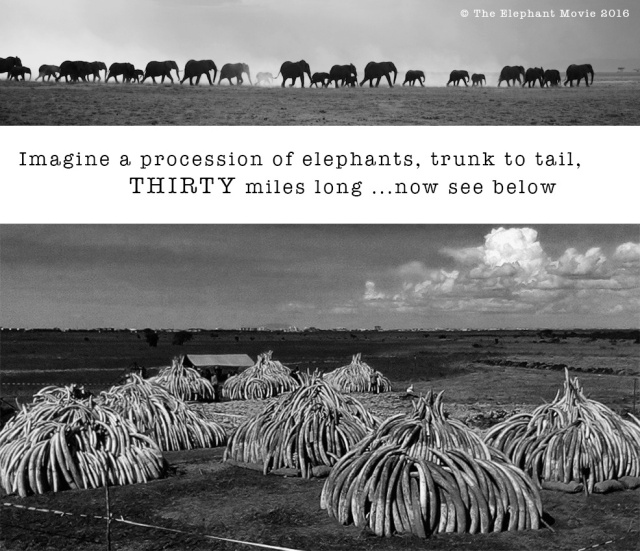
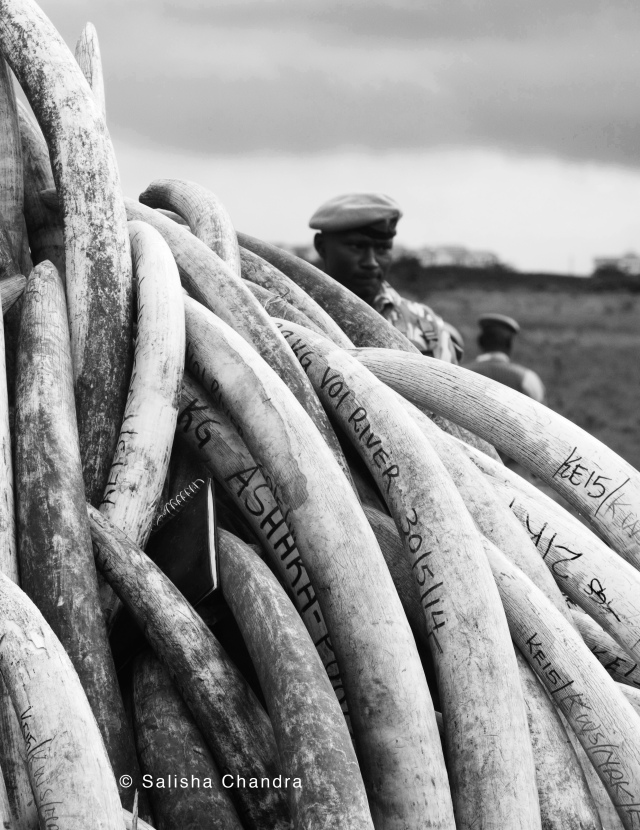
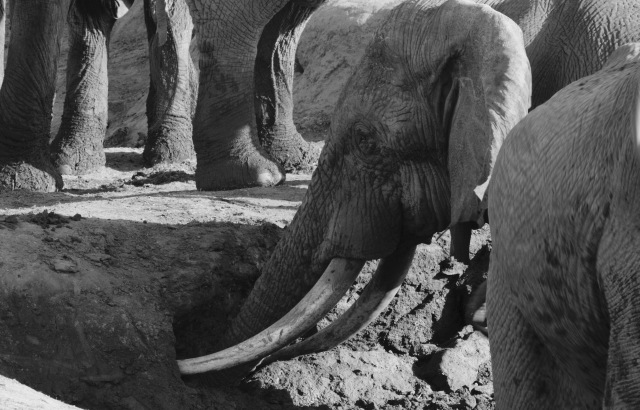
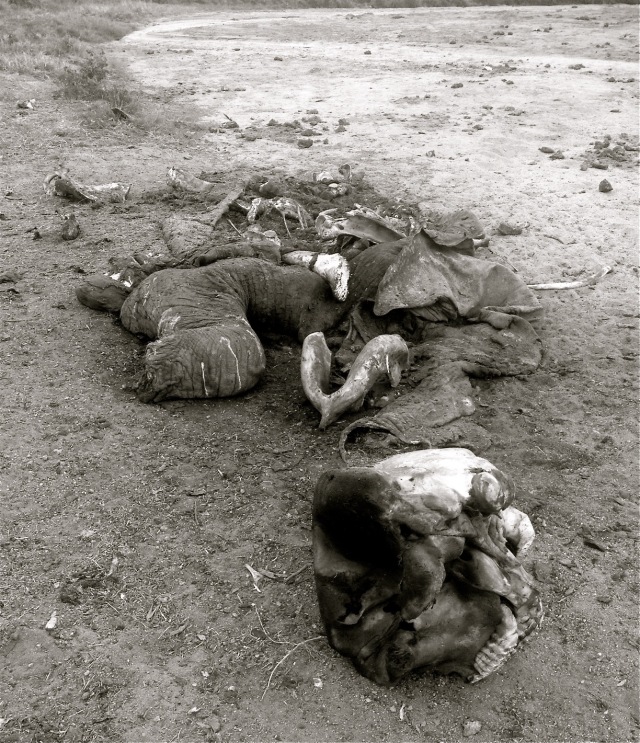
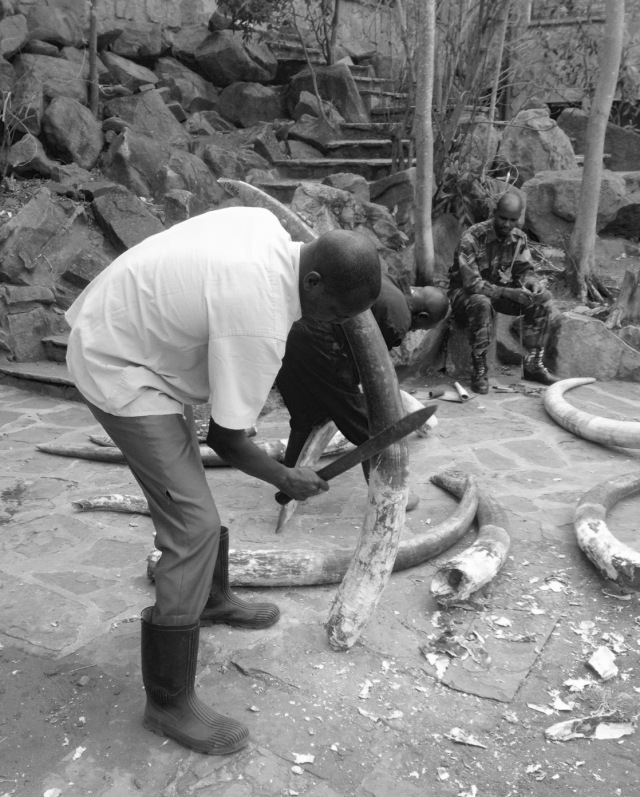
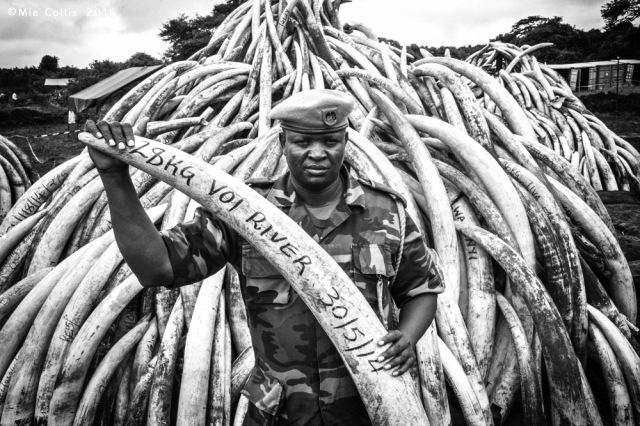
Every one of the tusks has such a story; seeing the pyres reminds me of fields of white crosses in Normandy or names of 9/11 victims, read aloud on every anniversary of the terrorist attack. Thank you for brining your personal attachment to a scene all the world should mourn.
Very moving, Mark…beautifully written too – Rich
Once again, Mark, you have touched my heart and soul for this elephant and all the others who have been uselessly killed. I want to cry.
Wow Mark- that was meant to be. Beautifully written as always…I am sad that the evidence of this monstrous slaughter is going up in smoke although I get why but I think in time we will have nothing tangible to remember those big tuskers…
Like the remains of human beings, they are being laid to rest. We will remember them in our hearts and minds, and through all the photographs and stories like this.
This breaks my heart. Mia took photos today… All so upsetting and sad…. Love Jxxx
Very powerful, Mark. Thank you for making that connection between a statistic, a tusk to be destroyed and a once-living animal.
Very, very moving Mark, if only it wasnt true.
So agree – if only it wasn’t true. Beautiful writing Mark
Reblogged this on It Is What It Is and commented:
Just imagine … how many elephants!! As you look at the pyres. This is heart wrenching!
Pingback: The story of a tusk … KG / VOI RIVER / 30/5/14 — Mark Deeble | nz
So desperately sad this continues. Thank you for this post. Pippa X
>
Reblogged this on "OUR WORLD".
You transported me there, so powerfully and poignantly written. I weep with you too. The shame of mankind.
I was born and raised in Kenya, know Voi well. My home is now in Dorset, but like you my heart is in Africa.
Thank you for that beautifully written post Mark. Your first-hand experiences and candid writing have such an emotional impact on all that read them. I will be taking time out on Saturday and will no doubt shed a tear to mourn the loss of these amazing creatures, so cruelly and crudely taken away from us. I prey this powerful visual helps to send a strong message and more importantly, aids the protection of future bulls.
I KNEW in my heart that there were tusks there from elephants
who were individually known by people – in that their daily lives and stories were known. Even their lives documented, because there must be some known to the Amboseli Research team, and to many other researchers, rangers and photographers. Thank you for finding him in the piles – and reminding us that he was a precious being, not just a chunk of ivory
This made me weep reading it. I find it perhaps even more poignant to learn about the life and death of a nameless elephant, because we know so much about the famed bulls like Mountain Bull, Satao and others so senselessly butchered. Every single elephant whose tusks are stacked in Kenya’s pyres had a life, history and identity known to them and other elephants. Thank you for this. It’s an extraordinary coincidence that you found that one single tusk by looking through photos, and could place that bull’s location, date of poaching and some of his life, and weave this moving story. I hope this helps everyone who views the pyres realize they are not just tusks, not just letters and numbers scrawled on the tusks, they were all individuals peacefully living their lives. And we need to save them from extinction. Incredibly poignant.
So beautifully put, dear Lori. At first I thought the story was about Satao, whose death I will never get over. Yes, tears for the unnamed magnificent being.
So heartbreaking…
Reblogged this on Animalista Untamed and commented:
This sad sad story brings a personal and poignant reality to those surreal facts and figures we are constantly seeing. Each pair of tusks represents a violation, a heartless taking of a life. Let us hope and pray that the new early detection system being trialled in Kenya now will prove a better protection for these majestic animals.
Beautifully written as always Mark. I’m sitting with tears in my eyes and a lump in my throat !!!
Beautiful and powerful story Mark. While others just see the tusks and ivory stockpile, the truth is that there are many stories of individual elephants lying in that pyre, as you have just affirmed. I too mourn the lives of elephants whose lives were senselessly cut short by human greed
Thank you Mark this day marks a memorial date both for the elephants and the elephant lovers and protectors. It also signifies a won battle in an epic war, that we all need endeavor to win EVENTUALLY. Elephants have as much right to be here as the rest of humanity and poachers should understand that!
Reblogged this on Jenna Brownson and commented:
Good morning, Dear Readers.
In a departure from writing something myself, I am sharing someone else’s words with you.
I have a special affection for elephants and for the Hindi god Ganesha, who is tattooed on my left inner wrist.
Some elephants will travel up to thirty miles in a day searching for water during the dry season. Imagine where you live and then going thirty miles in one direction. Think of how far that is.
Now read about another way to think of thirty miles.
I’ll be back on Monday. Have a thoughtful weekend.
Another great article, Mark. Thanks Brian
Sent from my iPhone
>
That is amazing. It’s just so emotional seeing all those tusks but to have that connection to one of those is amazing. Thank you
Theresa
Sent from my iPad
>
I’m trying to imagine a Kenya without the Lion, the Elephant, the Rhino, the Cheetah, and all other wild animals that are, lets face it, the primary reason visitors come from far and wide to view them. It is a dark and gloomy society, made more so because of our appetite for corrupt practices. Tomorrow is a sad day, I sincerely hope CITES never allow another “one off” trade window to sell Ivory. I sincerely hope that the trade results in a total shutdown of ivory carving factories globally. This madness needs to stop. We need to give our animals their space to live and move freely. Deeply moved today!
Very well written Mark. The burning will be a sad elegy for the poor souls that were murdered for greed. You have captured the emotions perfectly. let’s hope and pray that the tide will turn.
Great that so many people are re-blogging an important communication to the world. I am thinking of the whole chain of human greed that causes such senseless destruction of so many beautiful living beings. Thank you for writing Mark.
Thank you, Mark.
What an amazing story and the coincidence of that one tusk reappearing and jogging such precious memories! One last chance for his story to be shared with the world. . . thanks for writing a fine eulogy and testament to his life. His R.I.P. date is the same as Africa’s other elephant, Satao.
Reblogged this on Alexandra´s Animal Awareness Blog and commented:
Thank you to Animalista Untamed for bringing this blog post to my attention. Please read this moving and insightful piece on the burning of mountains of ivory.
What a heartbreaking story, but providential that you were able to make a connection to an elephant you once knew. I’m sorry this tragedy continues, but I must believe through efforts like yours we will stop the savagery once and for all.
Thank you for writing such a beautiful piece. I will absolutely reblog this…..getting everyone to connect on issues like this is so huge!
This was such a great post Mark – and what a blessing of a pic.
Etienne did a great assembly about it here for the children, and a follow up one yesterday.
They are all little Ele-ambassadors down this way for sure!
Hope you are all well and productive and enjoying the lightening days.
We miss having you here!
Lucy
Pingback: Why Kenya's ivory burning makes sense #worthmorealive historic burning
Reblogged this on Wolves of Douglas County Wisconsin.